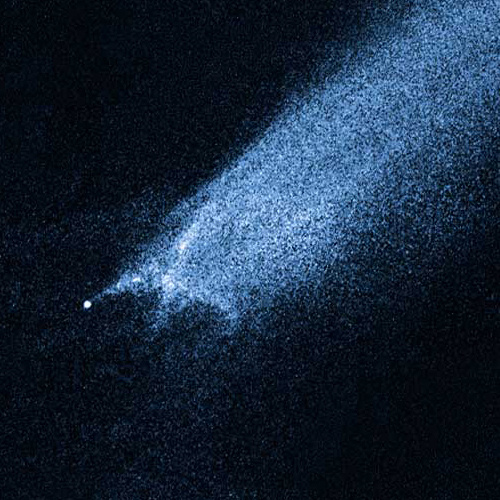The X marks the spot of a suspected head-on collision between two asteroids imaged by the Hubble Space Telescope’s new-and-improved Wide Field Camera.
If it’s confirmed by further observations, it would be the first time that scientists have detected the interplanetary collision between objects in the asteroid belt, though they believe that such occurrences are common.
The complex structure of the debris is what makes astronomers think they may be seeing something new around the sun. The main nucleus of the object, P/2010 A2, is actually located outside its dust halo, something that’s never been seen in a comet-like object before.
“The filamentary appearance of P/2010 A2 is different from anything seen in Hubble images of normal comets, consistent with the action of a different process,” said David Jewitt, an astronomer at the University of California Los Angeles, in a press release.
They hypothesize that the filaments are made up of dust and gravel created by a high speed impact that could have occurred at 11,000 miles per hour.
“If this interpretation is correct, two small and previously unknown asteroids recently collided, creating a shower of debris that is being swept back into a tail from the collision site by the pressure of sunlight,” Jewitt said.
Image: NASA, ESA, and D. Jewitt. XL version available.
Also see Hubble Detects Mysterious Spaceship-Shaped Object Traveling at 11,000MPH - P/2010 a2 - Gizmodo but note that the Wired article does not say that the object is traveling at 11,000 mph. That's about 3 miles per second, about the speed of Pluto.
Speed comparison
Right now you are moving with our planet at about 67,000 miles per hour around the sun. That's about 19 miles per second. Sound fast? Other planets orbit faster and slower than the Earth. Pluto, the slowest "planet" is moving at 2.9 miles per second. Mercury, the fastest, orbits the sun at 29.8 miles per second. For comparison light moves at 186,282 miles per second. In other words, my ship, the X-eno has not made the jump to light speed yet.
View on large image of P/2010 A2 on NASA.gov.
More from Wikipedia:
Comet P/2010 A2 (LINEAR) is a small Solar System body that displays characteristics of both asteroids and comets, and thus, was initially given a cometary designation. Since it has the orbit of a main-belt asteroid and yet shows the tail of a comet, it is listed as a main-belt comet. Analysis of images by the Hubble telescope suggests that its tail is generated by dust and gravel resulting from a recent head-on collision between asteroids rather than from sublimation of cometary ice. The position of the nucleus is remarkable for being offset from the axis of the tail and outside of the dust halo, a situation never before seen in a comet. The tail is created by millimeter sized particles being pushed back by solar radiation pressure.[6][7]
P/2010 A2 was discovered on January 6, 2010 by Lincoln Near-Earth Asteroid Research (LINEAR) using a 1 meter (36") reflecting telescope with a CCD camera. It has been observed over a 26 day arc of the 3.5 year orbit. Details of the exact orbit are still being refined which will allow more accurate orbital simulations. It appears to have come to perihelion (closest approach to the Sun) around the start of December 2009, about a month before it was discovered.
With an aphelion (furthest distance from the Sun) of only 2.6 AU, P/2010 A2 spends all of its time inside of the frostline at 2.7 AU.[8] Beyond the frostline volatile ices are generally more common. However, it is not yet possible to rule out the scenario that the active outgassing of P/2010 A2 is due to sublimation of ices hidden beneath the crust.
P/2010 A2 is likely about 150 meters (460 feet) in diameter. Even when it was discovered it was suspected of being less than 500 meters in diameter.
Another object, centaur 60558 Echeclus in 2006, was suspected of outgassing as a result of an undetermined splitting event.
The orbit of P/2010 A2 is consistent with membership in the Flora asteroid family, produced by collisional shattering more than 100 million years ago. The Flora family of asteroids may be the source of the K/T impactor, the likely culprit in the extinction of the dinosaurs.

1 comment:
This does not look like asteroids collided. But it does resemble some kind of space craft.Right now it is quite a mystery and scientist should stop peddling the asteroids collided trick.This mourning I observed a scientist and commentater talking about this on fox tv and they sounded non smart. This Does not look like two asteroids collided some one is lying. please comment on this post.
Thanks
private
Post a Comment